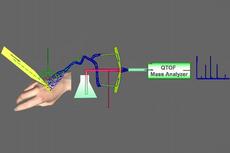On the trail of rotten meat
ETH Zurich researchers have developed a new method that allows even the surfaces of living organisms to be examined quickly and simply. The method opens up interesting new possibilities not only in medicine but also in food quality monitoring.

About 50 tons of rotten meat, even including old doner kebab skewers that had been processed, frozen, thawed and frozen again, was found by German police at the premises of a wholesaler in Bavaria last August. The astonished officers established that some of the faulty goods had passed their expiration date more than four years ago. The spectacular discovery was not a one-off case: last year alone wrongly declared elk goulash and rotten meat at a school in Kiel as well as other comparable cases in Frankfurt and Oldenburg made headlines in our northern neighbouring country.
The authorities in other countries are also worried that they are seeing increasing amounts of decayed food entering the distribution channels. The importance of efficient food quality monitoring is clear from the cases discovered so far. However, reliable measurement methods enabling large numbers of samples to be analysed quickly and economically are needed to make comprehensive monitoring possible at all. In the latest issue of the scientific journal Angewandte Chemie, the group led by Renato Zenobi, Professor of Analytical Chemistry at the Organic Chemistry Laboratory of ETH Zurich, has now presented a method that fulfils exactly these requirements.
Based on a standard instrument
The new analysis procedure represents a further development of the method recently published by the group, in which the researchers successfully detected various substances in breath in a simple way. Using their enhanced method, they can now also track down substances very precisely on surfaces of any kind.
Both methods are based on what is called a quadrupole time-of-flight mass spectrometer (QTOF mass spectrometer). Zenobi explains that “Such instruments are used routinely in many areas nowadays.” Samples for QTOF mass spectrometry are normally presented as a solution. This is solution is electrosprayed with the additional help of a desolvation gas, and the tiny droplets give rise to ions that are characteristic of the substance to be analysed and which the QTOF instrument measures. The Zurich researchers have now almost turned the principle upside down: instead of studying the substances in the solution, they now examine the substances present in the desolvation gas stream. Whereas in a conventional measurement the spray is generated with pure nitrogen, in their first method the researchers replaced the nitrogen by exhaled breathfrom test persons.. This enabled them to study the test persons’ breath in a simple way.
The newly-developed method no longer needs anyone to blow into the instrument. Instead, nitrogen is blown from a small nozzle onto any kind of sample surface. As the gas strikes the surface it desorbs semi-volatile substances from it. As in the first method, the “enriched” gas stream is then fed into the mass spectrometer where the absorbed substances can be analysed very precisely.
Equipment modification in less than an hour
Zenobi says “There is nothing special about the new method from the technical viewpoint.” Huanwen Chen, who developed the method as a post-doc in Zenobi’s group, demonstrated this impressively when he and Zenobi presented the new method to a company. Within one hour, Chen modified their mass spectrometer so it could be used to analyse the surface of objects of any kind.
However, the remarkable aspect of the new method is the wide variety of possibilities it opens up. “One particular strength of our approach is that even the surfaces of living organisms can be examined.” Zenobi is convinced that the method could also become an important tool in the field of food quality monitoring. “It takes only a few seconds to measure a single sample; so large numbers of random samples can be analysed routinely.” For meat samples the scientists were also able to show that the sample material does not even need to be thawed. For example, the modified mass spectrometer can detect traces of putrescine and cadaverine (tetra- and pentamethylenediamine) on frozen meat samples. These substances are released as bacterial metabolic products and – as their names indicate – they constitute indicators of defective quality.
Numerous possible applications
For vegetables the method could also yield useful information about possible health hazards. For example, the researchers analysed iceberg lettuce in their laboratory and successfully demonstrated which lettuce leaves were contaminated with E. coli bacteria and which were not. Zenobi illustrates the practical relevance of this kind of detection with an example from the USA, where in the autumn of 2006 about 200 people became ill after eating spinach contaminated with E. coli.
The studies carried out by the researchers with humans lead into a quite different direction. The scientists checked which substances were detectable on the skin of various test persons. In the case of a first test person, a 38-year old smoker, the measuring instrument was able to detect traces of nicotine. Drinking coffee also leaves an impression on the skin. The scientists observed a clear difference in the signal measured 30 minutes after the test person had consumed three cups of coffee. Traces of explosives and simulants for chemical agents, for example RDX and DMMP, can be detected on the skin of test persons. Zenobi says “The method’s strength is that it is fast, non-invasive, and needs no special sample preparation.” Another interesting fact is that it allows discriminating analyses: in the case of a second test person, a non-smoker aged 33, the researchers observed different spectra when they analysed the skin on the forehead, the abdomen and the feet.
In view of the numerous possible applications, it is not surprising that Zenobi is now in contact with various groups. The new method is of interest not only to food technologists and safety experts but also to medical professionals and drugs investigators in sport.








READER COMMENTS